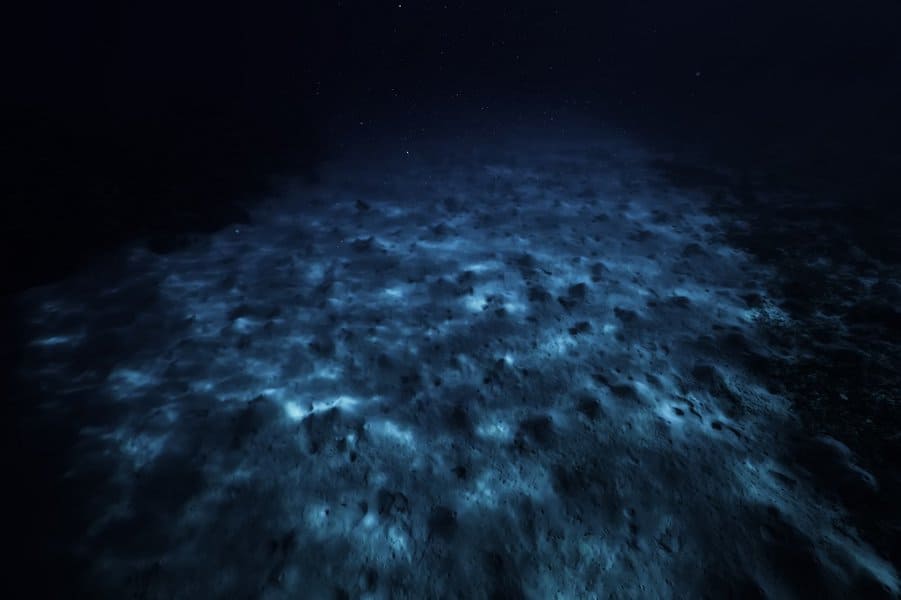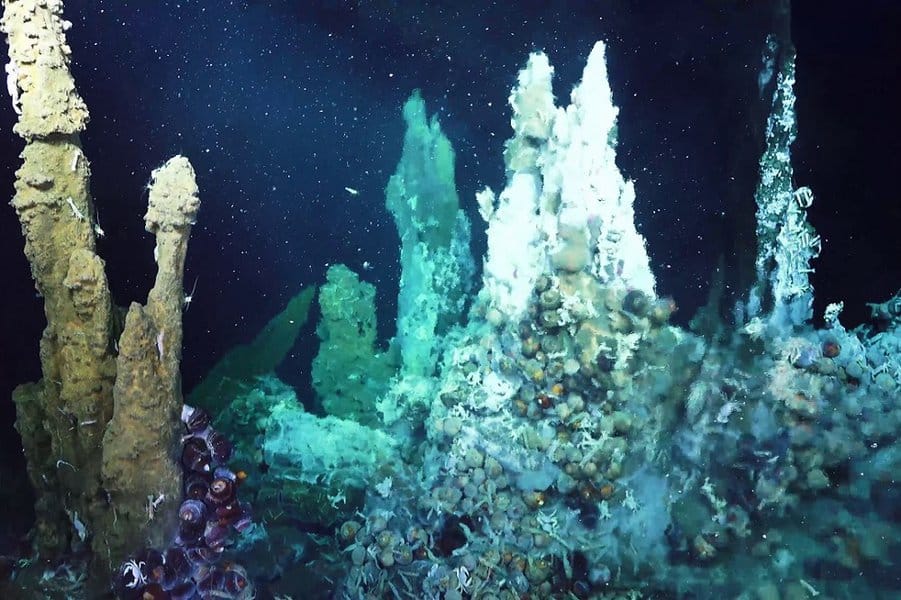
Ethan Daniels/Shutterstock
10 Amazing Facts About the Bottom of the Ocean
Scientists and researchers have studied the vast ocean for centuries. The sea is vital to the Earth and humans alike, covering roughly 70% of the Earth. The ocean breaks down into five main areas: Arctic, Southern, Indian, Atlantic, and Pacific. The bottom of the world’s oceans are some of the most fascinating places on Earth. There’s so much wonder deep in the sea that we haven’t yet discovered.
While most expect to find fish, sharks, whales, and other sea creatures, you’ll be surprised to discover all manner of interesting underwater creatures and hidden locations. Let’s travel to the bottom of the ocean and find the most fascinating facts about the deep blue.
10 Amazing Facts About the Bottom of the Ocean
1. The Deepest Point in the World

jefferyhamstock/Shutterstock
The Mariana Trench in the Pacific Ocean is the deepest point in the sea. It’s so deep that Mount Everest could fit in the area without reaching the surface. The deepest point is at the Southern end, known as Challenger Deep. The slope-shaped valley is roughly 38,500 feet from the surface to the bottom. The pressure from the water column is so intense that humans can’t reach the bottom. In fact, nothing grows that deep in the sea.
That said, there are a few sea creatures that thrive and survive on the trench’s sea floor. One example is a type of amphipod which usually lives in shallow waters. Scientists have discovered an amphipod species that found its way to the Mariana Trench and lives on the bottom of the sea. They’re able to survive partly because no predators live at that point in the ocean.
2. Lack of Sunlight

Kichigin/Shutterstock
The world’s ocean is dark and scary, mainly due to the lack of sunlight. Sunlight is vital to the existence and growth of life on the surface. However, sunlight only reaches the ocean’s surface, also known as the sunlight zone. The sun shines down on the sea, heating the temperature in the sunlight zone from 28°F to 97°F. The next layer, the twilight zone, is just beneath the surface and only gets a bit of sunlight.
From that point, the deepest sections of the ocean receive no sunlight at all. The midnight zone is roughly 3,000 feet below the surface and is pitch black with no sign of the sun. The midnight zone remains dark at all times, reaching a high of 39°F. For the most part, the deepest layer, known as the abyssal zone, is dark and freezing cold. In certain parts of the sea, the hadal zone is the deepest layer at 19,700 feet below the surface.
3. Abyssal Plain

Ethan Daniels/Shutterstock
The abyssal zone is the darkest and coldest point in the sea. Roughly 9,000 to 19,000 feet below the surface lies the abyssal plain. At this point, the seafloor is flat with some rocky sections. Due to the darkness, freezing temperatures, and distance from the surface, the abyssal plain remains one of the most mysterious places on the planet. With 70% of the bottom of the sea in darkness, most of it remains a mystery.
Scientists discovered creatures living at this point despite the lack of food. Due to the distance, food from the surface rarely reaches the abyssal plain, with several sea animals that live in the dark, deep depths of the ocean having to adapt and eat such things as worms, echinoderms, sea cucumbers, and mollusks.
4. High Pressure

neijia/Shutterstock
While these deep points in the sea fascinate humans, it’s impossible to further explore these areas due to the intense water pressure. The deeper you go, the greater the pressure. Just beneath the surface, the force of the water comes from all sides, known as hydrostatic pressure. The average pressure above the surface is known as atmosphere 1.
This is the pressure that most humans experience. The hydrostatic pressure increases the deeper you dive into the ocean, reaching a point that is unbearable to humans and most sea creatures. The pressure is double that amount 33 feet below sea level. The pressure then increases every 33 feet and is equal to another atmosphere pushing down. That’s why we as humans can’t go that deep into the sea as the pressure will crush us to death. Only specially made robots can dive deep into the bottom of the sea and find out what lies at the bottom.
5. Brine Lakes

EVNautilus/YouTube
Hundreds of people visit lakes every summer for fun family vacations. It turns out that lakes aren’t only on the surface. Deep in the ocean on the seafloor are numerous brine lakes. These lakes look identical to surface lakes. The water in these lakes is separate from the surrounding water. The brine lake waters remain independent because they’re saltier and denser than the surrounding water, which is why they sit near the bottom of the sea.
Brine lakes even make waves that are also separate from the ocean’s waves. Evidence suggests these lakes once sat in an ancient ocean from the Jurassic period. These lakes are full of bacteria and deadly gases, such as methane. Most animals would die instantly if they entered one of these lakes.
See more about - 14 Weird Things Found In The Ocean
6. Canyons

BBC/YouTube
Not only are there lakes beneath the ocean surface, but there is also an abundance of canyons. In addition to the abyssal pain, undersea canyons reach the bottom of the sea. These canyons spread throughout the sunlight zone right down to the darkest parts of the world’s oceans. They have an impact on the currents and temperature, with various sea creatures living in these complex canyons.
The water currents helped shape these canyons, making them ideal places to call home for many animals, such as crabs, squids, and octopuses. A surprising amount of whales live in canyons near the mid-Atlantic. The canyons are best fit for fish, corals, and sponges, with sharks also exploring the canyons from time to time to hunt prey.
7. Sea Creatures

Aquarius Traveller/Shutterstock
While several sea creatures live in the canyon, only a few can handle the pressure at the bottom of the ocean. Many animals are forced to adapt and evolve to their new surroundings. They have incredible ways of surviving in the cold darkness. Several creatures in the deepest points develop a bioluminescent glow to help light the way, while the single-eyed strawberry squid has unique vision, allowing it to spot bioluminescent creatures to feed on.
Then there is the gelatinous translucent snailfish that can withstand water pressure because of an enzyme it possesses that neutralizes the crushing force. Another creature that lives at the bottom of the ocean is the feather star. The fascinating creature disguises itself as a blooming flower on the ocean floor until predators pass and then swims away into the cold dark sea.
8. Whale Falls

Subphoto.com/Shutterstock
The majority of food and debris drifting down from the surface rarely reach the bottom of the sea. That’s why whale falls are vital to the survival of creatures and the ecosystem on the sea floor. Whales often die on the surface in shallow but warm waters. Known as “whale falls,” the whale’s body gradually descends to the sea floor. The whales are so large that they can support an entire ecosystem.
Sharks, crustaceans, and fish are usually the first to attack the whale’s carcass. These animals often spread particles to the lower levels of the ocean as they chow down, helping feed smaller worms, mollusks, and anemones on the bottom of the ocean floor.
9. Seamounts
Mount Everest is often called the tallest mountain in the world. It’s actually the tallest mountain above sea level. The most awe-inspiring mountains are below the surface in the deepest, darkest, and coldest parts of the sea. Also known as seamounts, these tall mountains significantly impact the temperature, currents, and life underwater.
Roughly 100,000 seamounts stretch throughout the world’s oceans. Many seamounts are ancient, such as the 100 million-year-old Bear Seamount in the Atlantic Ocean. The tallest mountain in the world, Mauna Kea, is a 30,000-foot-tall seamount that’s also a dormant volcano.
10. Hydrothermal Vents

Schmidt Ocean/YouTube
As noted, the majority of the ocean is freezing cold and dark. Due to the lack of sunlight, sea creatures have to find alternative options to get what they need to survive. Certain animals gravitate towards hydrothermal vents. These vents are one of the few places undersea that are hot, allowing an abundance of life to thrive. These areas occur when volcanic activity creates hydrothermal vents on the seafloor.
The ocean water rushes into the vents and returns heated up to 700°F thanks to the hot magma. The intense pressure at the bottom of the sea prevents vents from boiling the entire ocean. Several rare creatures live around the vents, such as the yeti crab. Living 7,000 feet below sea level near Easter Island, the yeti crab is one of the most fascinating ceatures of the sea floor.
See more about - 12 Ocean Mysteries That Have Baffled Humans For Centuries




